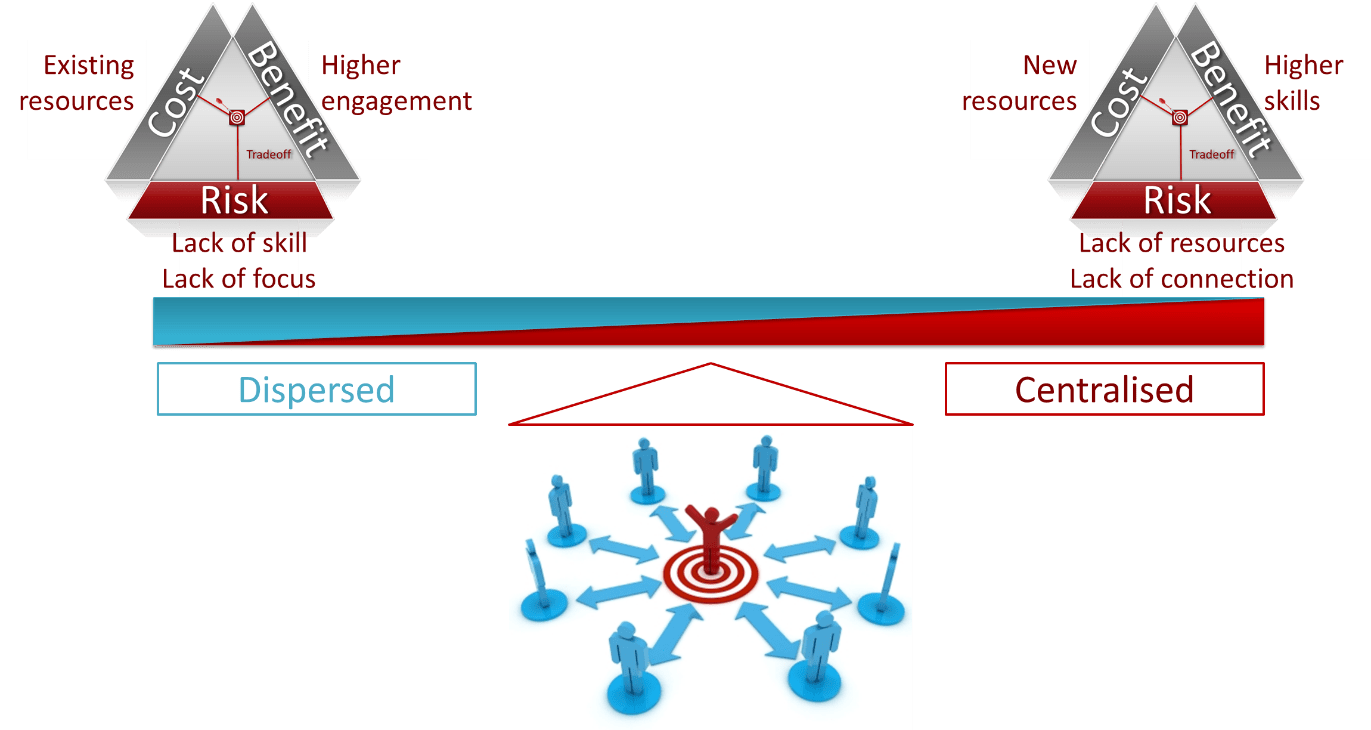At this point in the series, we have answered many of the technical questions regarding asset management. This article moves on to some of the human issues – how to build an asset management organisation and how to lead it to success. Nothing happens without an appropriate workforce structure, so let’s start with the organisation chart.
This is the seventh in a series of 13 articles on Implementing ISO 55000.
Articles in this series
Creating an asset management department
If you’re considering how to implement ISO 55000, you are probably working for an existing organisation. That means you are grappling with the complexities of locating and arranging human resources for asset management tasks in an environment where existing personnel are already fully employed and additional resources are difficult or impossible to obtain. This segment discusses the options, including the costs, risks and benefits and should help you prepare your business case.
While neither ISO 55001:2014 nor ISO 55002:2014 provide significant guidance on how to build an appropriate lower level structure to support an asset management system, our experience suggests that the possible models fall on a spectrum between the following two extremes:
- Fully dispersed model – everybody in the organisation is an “asset manager” with knowledge and skills matched to their specific role
- Fully centralised model – “all” asset management activities are undertaken in a single central area, staffed with genuine experts in the discipline of asset management
As with most spectra, there are costs benefits and risks associated with each option. The trade-off is illustrated in the following diagram:

As an organisation moves towards the dispersed end, it imposes higher and higher skill requirements on personnel that are not specialists in the asset management discipline. For example, maintenance experts might be required to lead the design of an asset management plan and then integrate content from projects, operations and disposals that they don’t really understand. This has the benefit of breaking down silos and forcing a “whole of organisation” approach, where everybody has an understanding of the purposes and benefits of asset management, but it creates risks around a lack of specialist asset management skills/knowledge and a lack of focus as already busy people add more tasks to their “to do” list. Ultimately, this has potential to undermine the effectiveness of the asset management system, with inconsistent, incomplete and inaccurate planning and execution of tasks.
One organisation we worked with was close to this extreme, where the division of responsibility was primarily functional, with each operational manager taking responsibility for a group of assets that were geographically and functionally linked. These managers had their own operational and maintenance resources, with central “technical” support minimised. This central support was also functionally grouped into (for example) projects, maintenance and information systems. There was no dedicated asset management workforce, although a reliability manager was appointed as part of the development of asset management capability and the technical manager would be considered the “champion” for asset management within the organisation. This arrangement was close to the “fully distributed” model and required minimal on-going investment in personal and modest temporary investment in consulting resources. Unfortunately, it was only partially effective as the various operational managers could not be held to account by the centralised technical support. More “teeth” in this organisation were required.
If the organisation reverses direction and tries to centralise its asset management activities, we see the above problems go away and another set of issues appear in their place. Firstly, the organisation needs to establish new positions with dedicated asset management skill sets and finding the resources to do this can be a challenge. Next, these highly skilled asset management experts need to find a way to engage with the day to day maintenance and operating activities of the organisation without creating a silo mentality, where asset management is seen as something done “over there” with no real connection to the actual workings of the organisation. If these challenges are not navigated successfully, then the asset management department will be under-resourced and disconnected from the remainder of the organisation. It will (quite rightly) be seen as an ineffective overhead and the asset management system will fail.
Another client organisation we worked with had an existing, strong, centralised asset management group which was charged with supporting the operational managers. This model was initially close to the fully centralised model, with the operational managers and their staff having minimal asset management skills. Unfortunately, it became clear that these operational staff had the essential knowledge to conduct asset management planning and the organisation needed to shift its strategy to build skills in this workforce. In this model, a larger investment in on-going resources was required to staff the asset management group, although consulting resources were minimised.
Perhaps the best gains we have seen with the implementation of asset management were in an organisation where there was already a strong discipline-based technical workforce (i.e. an electrical engineering department, a mechanical engineering department and so on). An asset management “centre of expertise” of just a few personnel fitted naturally into this organisational model and was able to focus on building processes and templates while the disciplines applied these templates to their particular classes of asset. This required a moderate on-going investment to staff the centre of expertise, but with consulting resources only required to transfer new knowledge and skills into the organisation.
In our opinion, this “centre of expertise” structure located between the two extremes is the most likely to generate a sustainable improvement in asset management capability. The exact size and structure will depend on the organisation, so we offer the following guidance to support selection of an appropriate structure:
- There must adequate resources to prepare asset management tools, templates and processes as required
- These resources may be any mix of consulting, specialist asset management or other staff as appropriate to the specific organisation
- The asset “owners” must be actively engaged with asset planning, regardless of who is nominally responsible for this process
- Every individual must possess competencies appropriate to their specific roles and responsibilities
There is one more key ingredient – there must be what we like to call a “visible champion” amongst top management and they must have sufficient control over the asset management resources to drive the system forward. Of course, control over the resources is not the only requirement for this visible champion, so let’s take a deeper look at who they might be and where they might fit.
Finding an asset management champion
The requirement for a visible champion is part of the ISO 55001:2014 requirement for the organisation to assign and communicate relevant roles, responsibilities and authorities (clause 5.3) [2]. These clauses recognise the fundamental importance of high level accountability for the asset management system if the system is to be effective. Where, then, should this high level accountable manager sit?
In one organisation we have worked with, a specific but temporary position was created at the executive level to oversee the creation of the asset management system. When this temporary position ceased, the responsibility reverted to another executive who was already heavily tasked with line management of a significant element of the asset portfolio. A small number of staff, including a mid-level manager were also transferred. We saw the following:
- The organisation made good progress while the temporary position was in place
- The true “champion” of asset management became the mid-level manager when the temporary position ceased
- Progress slowed significantly when the temporary position ceased
- The organisation had no success in implementing asset management practices beyond the executive’s area of responsibility
In another organisation, the “champion” was the senior technical manager, who reported to the operations executive. In this structure, we observed a reluctance for asset management activities to be directed at the organisation’s real problems, with artificial boundaries drawn around the technical and operating disciplines.
We note from these examples that accountability is not enough. To create a reasonable chance of success in an asset management implementation, we suggest that the accountable manager needs to have the following characteristics:
- The executive’s existing responsibilities must span the full asset portfolio
- The executive’s existing responsibilities must span the full asset life cycle
- The executive must be motivated and committed to implementing an effective asset management system
This last criterion is particularly important and is why we prefer the term “visible champion”, which gives a sense of how the individual must act to engender success.
Given the criticality of visible top management support to success of any change initiative, the preferred approach to implementing an asset management system must be to appoint a dedicated executive-level “champion.” We acknowledge, however, that this is simply not practical for most organisations and a suitable position must be found from within the existing executive workforce. Our criteria suggest allocation of asset management accountability (and, therefore, associated resources) to either the operations executive or a corporate strategy/risk executive. It should be noted, however, that such individuals may require significant support to understand their responsibilities as the majority of asset management professionals currently come from technical backgrounds.
One more note on leadership: top level involvement is essential, but this does not mean that mean that asset management leadership stops with the CEO. Leadership is independent of organisational position, and a Maintenance Manager, an Operations Supervisor, or even a Reliability Engineer can still shape the culture within their circle of influence and create meaningful change. There will be limits to what you can achieve at lower levels in the organisation – particularly where your people interact with those from other workgroups who may not share the same cultural beliefs or perspectives. Nevertheless, you CAN make a difference.
Conclusion
Just as with so many other elements of asset management, there is no one right structure for an asset management organisation. There are, however, some clear principles to follow in designing yours: adequate resources with appropriate competencies and engaged asset owners. These principles point towards a “centre of expertise” structure, where a small group of asset management professionals provide tools, training and advice to support the rest of the organisation to manage their assets.
The organisation also needs to identify a visible champion that will not just hold the accountability for asset management but also provide the leadership and guidance to make it happen. We suggest that the ideal solution is a dedicated executive, but also acknowledge that this will often be impossible. In such cases, it is worth looking beyond the technical side of the workforce as operations or corporate risk executives might have broader interest in the life cycle management of the assets, provided they have adequate links to technical experts to mitigate any shortcomings in their knowledge.
Good luck and happy organising! If you believe you need assistance to design or enhance your organisational structure to promote better asset management, we would be delighted to hear from you. Click here to request an obligation-free consultation with me or one of our other experienced consultants.
Looking for further training in ISO 55001 certification?
We offer a range of asset management courses, some of which specialise in ISO 55001 deliverables. If you are interested in reading more about our courses, you can do so by following the links below.
-
Product on sale
 Implementing an ISO 55001 Compliant Asset Management SystemOriginal price was: $2,275.00.$2,047.50Current price is: $2,047.50.
Implementing an ISO 55001 Compliant Asset Management SystemOriginal price was: $2,275.00.$2,047.50Current price is: $2,047.50. -
Product on sale
 Asset Management Foundation AwardOriginal price was: $1,195.00.$1,075.50Current price is: $1,075.50.
Asset Management Foundation AwardOriginal price was: $1,195.00.$1,075.50Current price is: $1,075.50.
[2] ISO 55002:2014 Asset management – Management systems – Guidelines for the application of ISO 55001; p.6


